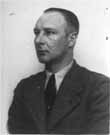
|
|
|

|

|

|

|
|
Click on an image to see a larger, more detailed picture.
|
|
|
|
|
| 1941: Mass Murder |

|
pg. 225 |

|
|
|
|
| |
 In 1941, a year before deportations from the Warsaw Ghetto reached their height, ghetto leaders made brave attempts to retain a certain sense of normalcy, and to provide for the physical and emotional needs of the ghetto's children. The care center seen here, and others like it, were vital because they provided children with food and the perception of safe havens. Care centers were possible because a Nazi ban on public and private "gatherings" was rescinded early in 1941. Elementary-school instruction also was allowed. The "normalcy" was illusory, however, and conditions faced by Warsaw's children would shortly be insufferable.
In 1941, a year before deportations from the Warsaw Ghetto reached their height, ghetto leaders made brave attempts to retain a certain sense of normalcy, and to provide for the physical and emotional needs of the ghetto's children. The care center seen here, and others like it, were vital because they provided children with food and the perception of safe havens. Care centers were possible because a Nazi ban on public and private "gatherings" was rescinded early in 1941. Elementary-school instruction also was allowed. The "normalcy" was illusory, however, and conditions faced by Warsaw's children would shortly be insufferable.
Photo: Beth Hatefutsoth
|
 Viktor Brack, a former chauffeur to Heimrich Himmler, raised funds for medical experiments during the Holocaust. A colonel in the SS, Brack was Hitler's special advisor on the T-4 "euthanasia" program. So immersed was he in the program that he personally met and interviewed each physician who ultimately participated. Brack also was one of those who decided to use poison gas as the preferred extermination method.
Viktor Brack, a former chauffeur to Heimrich Himmler, raised funds for medical experiments during the Holocaust. A colonel in the SS, Brack was Hitler's special advisor on the T-4 "euthanasia" program. So immersed was he in the program that he personally met and interviewed each physician who ultimately participated. Brack also was one of those who decided to use poison gas as the preferred extermination method.
Photo: Berlin Document Center / United States Holocaust Memorial Museum Photo Archive
|
 Professor Julius Hallervorden, a pathologist at the Kaiser-Wilhelm Institute, was one of the many German physicians who willingly participated in the "euthanasia" program to eliminate the mentally ill and physically disabled from German society. Many doctors later collaborated in horrendous medical experiments and in choosing which concentration-camp prisoners were temporarily to live and which immediately to die. German physicians joined the Nazi Party at a higher proportional rate than any other profession in Germany.
Professor Julius Hallervorden, a pathologist at the Kaiser-Wilhelm Institute, was one of the many German physicians who willingly participated in the "euthanasia" program to eliminate the mentally ill and physically disabled from German society. Many doctors later collaborated in horrendous medical experiments and in choosing which concentration-camp prisoners were temporarily to live and which immediately to die. German physicians joined the Nazi Party at a higher proportional rate than any other profession in Germany.
Photo: Max-Planck Gesellschaft / United States Holocaust Memorial Museum Photo Archive
|
 Hitler's ambition and megalomania were boundless. This decorative desktop globe, removed from the Führerbunker by Soviet troops in 1945, carries a pair of unnerving German-language inscriptions. Atop the Soviet Union are the words "I am coming." The inscription over North America reads, "I will be there soon."
Hitler's ambition and megalomania were boundless. This decorative desktop globe, removed from the Führerbunker by Soviet troops in 1945, carries a pair of unnerving German-language inscriptions. Atop the Soviet Union are the words "I am coming." The inscription over North America reads, "I will be there soon."
Photo: AP World Wide Photos
|
|

|

|

|
|
|
|
|
| 1941: Mass Murder |

|
pg. 225 |

|
|
The Holocaust Chronicle
© 2009 Publications International, Ltd.
|
|
